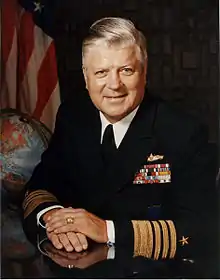Harry D. Train II
Harry Depue Train II (born November 5, 1927) is a retired United States Navy admiral and a Senior Fellow at the Joint Advanced Warfighting School at the Joint Forces Staff College in Norfolk, Virginia.[2]
Harry D. Train II | |
|---|---|
 Official portrait of Admiral Harry D. Train II, August 1982 | |
| Born | November 5, 1927 Washington, D.C.[1] |
| Allegiance | United States |
| Service/ | United States Navy |
| Years of service | 1949–1982 |
| Rank | Admiral |
| Commands held | Supreme Allied Commander Atlantic United States Atlantic Command United States Atlantic Fleet United States Sixth Fleet Carrier Strike Group 6 Cruiser-Destroyer Flotilla 8 USS Conyngham (DDG-17) USS Barbel (SS-580) |
| Battles/wars | World War II Korean War |
| Awards | Defense Distinguished Service Medal Navy Distinguished Service Medal (4) Legion of Merit (4) |
| Relations | Rear Admiral Harold C. Train (father) Rear Admiral Elizabeth L. Train (daughter) |
Naval career
Train was admitted to the United States Naval Academy in 1945 and graduated in 1949.
Train's operational commands included the attack submarine USS Barbel (SS-580); the guided missile destroyer USS Conyngham (DDG-17); Cruiser-Destroyer Flotilla 8; the John F. Kennedy Battle Group; and from August 1976 to September 1978, the United States Sixth Fleet in the Mediterranean Sea.
His principal staff duties included Director of the Joint Staff, Office of the Joint Chiefs of Staff; Executive Assistant to the Chairman, Joint Chiefs of Staff; and Executive Assistant to the Chief of Naval Operations. He served as aide to Chairman of the Joint Chiefs of Staff Admiral Thomas H. Moorer.
From 1978 to 1982, Train served as the North Atlantic Treaty Organization's Supreme Allied Commander Atlantic as Commander-in-Chief, United States Atlantic Command and as Commander-in-Chief, United States Atlantic Fleet. He retired from the navy in 1982.
Personal life and post-military service
The son of Rear Admiral Harold Cecil Train (1887–1968) and May Philipps Train (1889–1980),[3][4] he graduated from the Georgetown Preparatory School in 1945 and the United States Naval Academy in 1949.
Train and his wife, Catherine, have four daughters, including Rear Admiral Elizabeth L. Train.[5]
In 1956, he joined the District of Columbia Society of the Sons of the American Revolution.
After retiring from full-time military service, Train worked for Science Applications International Corporation (SAIC), the nation's largest employee owned research and engineering company. He retired from SAIC as its Manager, Hampton Roads Operations, in September 2006.[2]
Train served as a commissioner on the U.S. Commission on National Security/21st Century.[6] He is a member of the Board of Trustees of the Old Dominion University Research Foundation,[2] and was the long-time president of the Future of Hampton Roads, a group of civic leaders who work toward regional solutions in Hampton Roads, Virginia.[7]
Awards and decorations
 | ||
| Badge | Surface Warfare Officer Pin | ||
|---|---|---|---|
| 1st Row | Defense Distinguished Service Medal | ||
| 2nd Row | Navy Distinguished Service Medal with three gold stars | Legion of Merit with three gold stars | Meritorious Service Medal |
| 3rd row | Joint Services Commendation Medal with oak leaf cluster | Navy and Marine Corps Commendation Medal | China Service Medal |
| 4th row | American Campaign Medal | World War II Victory Medal | Navy Occupation Service Medal |
| 5th Row | National Defense Service Medal with service star | Korean Service Medal with two battle stars | Order of Naval Merit (Brazil), Grand Cross |
| 6th row | Order of the Republic (Tunisia), Commander | Republic of Korea Presidential Unit Citation | United Nations Korea Medal |
| Badge (not shown) | Supreme Allied Commander Atlantic | ||
See also
| Military offices | ||
|---|---|---|
| Preceded by Isaac C. Kidd, Jr. |
Commander-in-Chief, United States Atlantic Fleet September 30, 1978 - September 30, 1982 |
Succeeded by Wesley L. McDonald |
| Preceded by Frederick C. Turner |
Commander-in-Chief, United States Sixth Fleet August 1976 – September 1978 |
Succeeded by James D. Watkins |
| Wikimedia Commons has media related to Harry D. Train II. |
References
- "Supplement to Who's who in America". 1987.
- Old Dominion University Research Foundation Archived 2017-09-18 at the Wayback Machine.
- Obituary of Cecil Train Wilson, The Washington Post, October 27, 2006
- USNA Cemetery Documentation Project
- U.S. Navy Biographies Archived 2012-03-23 at the Wayback Machine
- "Statement of the Hon. James R. Schlesinger and Admiral Harry D. Train (USN, Ret.) for the U.S. Commission on National Security/21st Century, U.S. Senate website" (PDF). Archived from the original (PDF) on 2010-01-12. Retrieved 2009-10-31.
- Future of Hampton Roads website